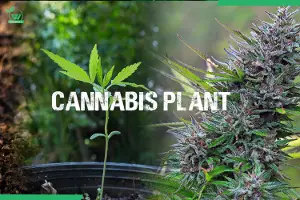Cannabis Plant: Comprehensive Guide to Benefits, Types, and Cultivation

The Cannabis sativa plant is a herbaceous species that has both euphoric and medicinal properties. It has been cultivated for generations for fiber, oil, and recreational uses. Cannabis contains cannabinoids, such as THC and CBD, which have a profound impact on the body.
THC is renowned for its recreational benefits, but CBD is valued for its medical properties. The plant's potential for medical and industrial uses is becoming apparent. This guide explores the plant's key components, types, legal status, and cultivation techniques.
Understanding the Cannabis Plant
What exactly are the Components of Cannabis?
Cannabis includes about 120 cannabinoids. Experts recognize two cannabinoids: cannabidiol (CBD) and tetrahydrocannabinol· Each has its effect and function:
Cannabinoids
-
Cannabidiol (CBD):
This is a psychoactive cannabinoid, but it is nFot intoxicating or euphoric, so you will not feel "high." It's commonly used to manage pain and inflammation. CBD may help with nausea, migraines, seizures, and anxiety.
Epidiolex is an FDA-approved prescription medication containing CBD. This medicine is prescribed to treat some forms of epilepsy. Researchers are still investigating CBD's potential medical applications.
-
Tetrahydrocannabinol (THC):
This is cannabis' primary psychotropic component. THC is responsible for the often associated "high" with cannabis.
Facts Corner: Components of Cannabis
- Cannabis contains over 120 cannabinoids.
- CBD is non-intoxicating and helps manage pain and inflammation.
- THC is the main psychoactive component responsible for the 'high'.
This article is according to a study by the National Institute on Drug Abuse (NIDA) on Cannabis (Marijuana) DrugFacts.
Different Types of Cannabis
The majority of people are unaware that there are thousands of hybrids, much less three families, and that it is rejected as a chemical that can lead to addiction (which is not accurate). Each of these plants has a variety of benefits.
1. Cannabis Sativa
Sativa plants originated in tropical regions with a more balanced light cycle. They can reach 20 feet or more during flowering and yield more due to their longer flowering time. Sativa plants feature elongated and pointed leaves. Some people describe it as finger-like.
Facts Corner: Cannabis Sativa
- Originated in tropical regions.
- Can grow up to 20 feet tall.
2. Cannabis Indica
Indica plants developed in subtropical climates with more flexible light cycles. They typically start flowering as soon as they reach maturity. Commercial farmers benefit from rapid growth, which allows for increased productivity and profitability.
Indica plants have bigger leaves than Sativas and look like a fan. It normally reaches a height of 3 to 9 feet. Due to its shorter physical structure, numerous individuals prefer growing it inside.
Facts Corner: Cannabis Indica
- Develops in subtropical climates.
- Typically grows between 3 to 9 feet tall.
3. Cannabis Ruderalis
Ruderalis is the shortest of the three cannabis families, with an average height of 1 to 2 1/2 feet. This bushy shrub has thick stems and large leaves. Ruderalis contains far less THC and CBD than the other two. Many people consider it ineffective for both recreational and medical purposes.
Facts Corner: Cannabis Ruderalis
- Shortest of the three cannabis families.
- Contains less THC and CBD.
Difference Between a Male and Female Cannabis Plant
Identifying male and female weed plants can be challenging. It's crucial to understand the difference between them.
Male Cannabis Plant
Males generate pollen for plant reproduction, leading to seed production. Avoid this plant for higher bud yields. Whether to remove these plants depends on the gardener's plans. Plants achieve sexual maturity when they bloom.
Male marijuana plants develop tiny "balls" that serve as pollen sacs for only three weeks. To avoid pollination, move the plants to a new container or cultivation location as soon as they are recognized. Look for a banana cluster with no hairs (pistils). The female fruit is spherical and smaller than the male fruit, which is slender and long.
Female Cannabis plant
Female plants, on the other hand, are in high demand among cannabis cultivators. They are responsible for creating buds, which contain the most THC. If a male and female marijuana plant share the same growth environment, even a tiny amount of pollen might produce seeds that are worthless.
To tell females apart, look at their flowers, which are much more open and have projecting hairs (pistils). It will be simple to identify them because the first thing to grow will be their hair. They are thin and long, as opposed to the male fruit, which is rounder and smaller.
Facts Corner: Male vs. Female Cannabis Plants
- Males produce pollen; females produce buds.
- Female plants are preferred for higher THC content.
Is Cannabis Legal?
Cannabis is still illegal in many areas, but it is becoming more accessible for recreational and medical use. In the United States, recreational and medical cannabis are already legal in some states.
While several countries have recognized cannabis for medical use, it is still illegal under federal law in the US. CBD has been shown to treat inflammation and discomfort effectively. Epidiolex, a CBD-based prescription medicine, has been shown to treat certain types of seizures effectively.
Facts Corner: Cannabis Legality
- Legal in some U.S. states for recreational and medical use.
- Epidiolex, a CBD-based drug, is FDA-approved for certain seizures.
How to Grow a Cannabis Plant
The first and most crucial step is to choose high-quality seeds· You can select either feminized seeds, which ensure female plants, or auto-flowering seeds, which are easier to nurture· Researching trustworthy seed banks assists in ensuring that you begin with the most excellent genetics for your preferred strain·
1. Choosing the Right Seed
Choosing the right seeds is crucial for growing cannabis. Feminized seeds produce only female plants, ensuring higher yields of THC-rich buds. Auto-flowering seeds transition from vegetative to flowering stages based on age, making them easier for beginners. Selecting high-quality seeds from reputable seed banks leads to healthier plants and better yields.
2. Germinating the seeds
Place your seeds between moist paper towels in a dark, warm location to germinate· After a few days; the seeds will develop little roots· Once the roots develop, carefully transfer the seedlings to your preferred growing medium, such as soil or a hydroponic system·
3. Providing proper lighting
Cannabis plants require a lot of light to flourish· When growing indoors, utilize high-quality grow lights, such as LED or HID lights, and keep the light cycle at 18 hours during the vegetative phase· For outdoor cultivation, your plants should receive at least 6-8 hours of direct sunlight per day·
4. Ensuring adequate nutrition
Cannabis plants require a well-balanced fertilizer mix that includes nitrogen, phosphorus, and potassium, as well as trace minerals· Use high-quality cannabis fertilizer and strictly adhere to the feeding schedule· Overfeeding or underfeeding can be detrimental to the plants, so keep an eye on their response and adjust accordingly·
5. Managing water and humidity
Water your plants regularly, making sure the soil is moist but not saturated· Proper drainage is required to prevent root rot· Maintain humidity levels between 40-60% throughout the vegetative stage and slightly lower during flowering to prevent mould and mildew·
6. Monitoring growth stages
Cannabis plants have four unique growth stages: germination, seedling, vegetative, and blooming· Each stage has distinct requirements for light, nutrients, and maintenance· Keep a close eye on your plants' development and change your care regimen as needed to promote healthy growth·
7.Pruning and training
Pruning improves air circulation and light penetration, while training methods such as topping, LST (low-stress training), and SCROG (screen of green) can increase yield· Remove any dead or yellowing leaves, then train the branches to form an even canopy·
8. Harvesting and curing
Harvesting begins when the buds have matured and the trichomes have turned hazy or amber· Cut the plants and trim the buds, then hang them upside down in a dark, calm, and well-ventilated location to dry· After drying, place the buds in airtight jars and open them daily to remove moisture while offering a smooth smoke·
9.Enjoying your harvest
After a few weeks of curing, cannabis is ready for use. Whether you like to smoke, vape, or consume cannabis, the results will be rewarding. Store cannabis in a cool, dark environment to maintain its strength and flavor.
Conclusion
The cannabis plant's psychotropic and medicinal characteristics have led to a substantial shift in global perceptions and legal status. Research is highlighting its potential therapeutic benefits for chronic pain, epilepsy, and anxiety.
Legalisation has boosted economic growth, produced jobs, and increased tax revenue. However, it raises questions over regulation, youth access, and public health. Balancing factors is critical as nations integrate cannabis into their legal and cultural frameworks to maximise its benefits while avoiding its drawbacks.
For more information on the benefits of Cannabis , check out our detailed article Benefits of Cannabis.
FAQ's
Q1. How is the cannabis plant used?
Cannabis is widely used for recreational and therapeutic purposes, including treating multiple sclerosis and nerve pain. Although claimed to cure nausea, vomiting, migraines, and other ailments, there is limited scientific evidence to support these claims.
Q2. What is the most commonly used type of cannabis?
Indica is arguably the most common form of cannabis. Indica strains have a stronger effect, lowering pain, anxiety, and insomnia.
Q3. What does the cannabis plant look like?
The marijuana plant is a tall, green, and leafy herb. The leaves are green and jagged, with a peculiar aroma and flavour. Marijuana plants produce clustered, small blooms in green, yellow, orange, and purple.
Q4. What are the two kinds of cannabis plants?
The cannabis plant has two forms of weed: indica and sativa.
Q5. What are the most popular cannabis strains?
Sour Diesel, Purple Kush, and Blue Dream are among the most popular.



.png)
Comment